


















FONTERRA SAYS it must set a target for scope 3 emissions from supplying farms or risk losing global business contracts to rival processors.
The co-operative plans to start talks with its 9,000 supplying farms soon on what a scope 3 emissions target may look like.
Scope 3 emissions include carbon emissions not produced by the company itself, but by those that it’s indirectly responsible for, like farmers.
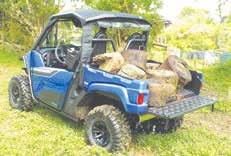
Fonterra chief executive Miles Hurrell told Dairy News that 91% of its group emissions are from behind the farm gate.
He says the co-operative is under increasing pressure from both customers and consumers, and more and more from the finance sector, to put out a scope 3 emissions target.
Hurrell and Fonterra chair Peter McBride both gave farmers a heads up on looming scope 3 emissions target in their speeches at the coop’s annual general meeting last month.

Since the announcement, there has been a wide range of views among Fonterra farmers.


Hurrell says while some farmers are anxious, a majority of them are looking for clarity. “We felt it was our duty to let them know at the AGM that this is the pull we are getting from consumers and customers and the finance sector.”
He points out that most of Fonterra’s major customers now have their own scope 3 emissions target.

“So, they are looking for us, as a supplier to them, to ensure that we have our targets in place,” he says.
“They will give us some time to get there but we don’t want to be in a position where, if we can’t come up with a target, they look at alternatives.
“Those alternatives may be other sources of dairy: globally there are other dairy companies that have set themselves scope 3 emissions target.
“But more importantly, it’s
making sure they don’t look at alternatives that do not include dairy. That’s an even bigger risk to us.”
Hurrell says it’s too early to talk about timeframes but the co-op hopes to start discussions with farmers in the coming months.
“It’s an important part of our journey and it’s also important we work with our farmers on that journey,” he says.
The co-op hopes to discuss possible targets, timeline and understand from farmer shareholders what can be achieved. The science behind the targets and initiatives the co-op may
offer farmers will also be discussed.
At Fonterra’s AGM, McBride told farmers that from his perspective, setting a scope 3 target will help the co-op maintain competitive access to key international markets.
“For example, the EU has proposed a carbon border adjustment tax on certain carbon-intensive goods,” he said.
“They are subject to a carbon emissions price via the EU’s Emissions Trading Scheme. Agriculture is not currently in scope, but it is possible it will be brought into the scheme.”
FONTERRA LAST week lifted its earning guidance for this season but narrowed its forecast farmgate milk price due to softening whole milk powder prices.
The co-op’s new earnings guidance is 50-70c/ share, up from 45-60c. However, its forecast farmgate milk price range drops from of $8.50-$10/ kgMS to $8.50-$9.50/ kgMS.
The new midpoint for the forecast milk price is
$9/kgMS, a drop of 25c, but the co-op is holding its advance rate paid to farmers monthly for milk.
Fonterra chief executive Miles Hurrell says it was a positive start to the year given the current global operating environment.
“We continue to feel the impact of geopolitical and macroeconomic events, with higher costs at every point in our supply chain.
“It’s a similar story
behind the farm gate with our farmer shareholders managing significantly higher input costs.”
The co-op reports that globally, milk supply from key exporting regions is down over the last 12 months.
Production in Europe and Australia continues to be down, with US milk supply showing a slight improvement in recent months. In New Zealand, Fonterra’s milk production is down 2.9% on the
sions over the life of the assets.
SOLAR panel provider Solagri
Energy recently received a $10m boost from investment bank New Zealand Green Investment Finance (NZGIF).
Solagri provides a ‘solar as a service’ option tailored to New Zealand dairy farms.

The company’s arrays are normally ground mounted on a quarter hectare close to the dairy shed, providing the farm with low-cost electricity with longterm energy price security.
The $10m debt finance facility is expected to fund approximately 120 solar arrays over the course of the next three years. Those arrays are expected to help avoid 36,100 tonnes of CO₂ emis-
Solagri chief executive Peter Saunders says the investment comes at a time when farmers are looking at different ways to cut costs and save money.
He says his company’s Power Purchase Agreement (PPA) offering gives farmers price stability without increasing debt, thus enabling them to focus on their investment in their core business.
“We currently have eight systems at differing stages of consenting and construction and a lot of new work coming down the pipeline. We’re looking forward to expanding that rapidly in the next few years thanks to this facility from NZGIF,” Saunders says.

“Solar energy makes a lot of sense for farmers but there hasn’t been a realistic renewable energy option for them until now.
“Our PPA-driven model allows farmers to have their cake and eat it too,” he says.
The Solagri solar arrays have no upfront capital cost attached to them and provide reduced energy costs over time, in addition to helping with the annual Sustainability Audit. Saunders says this means farmers can then invest in other projects like herd monitoring and automation systems.
“It’s a bit of a no-brainer.”
NZGIF chief investment officer Jason Patrick says the bank’s purpose is to accelerate investment in the decarbonisation of New Zealand.
“As a green investment bank, we are a commercial investor and generate returns on our investments that will be recycled into new investments over time,” Patrick told Dairy News
“By providing Solagri with financing for more solar installs on dairy farms, we see this investment as a positive step towards the decarbonisation of New Zealand.
“Given the importance of the farm sector in New Zealand, we are particularly pleased to support this in initiative,” he says.
Patrick says there are many opportunities for the bank to invest in the transition to more renewable energy resources to move New Zealand closer to net zero carbon emissions.
“This investment does not preclude us from making investments with other solar developers. In fact, we currently provide debt facilities for solarZero’s residential, commercial and school solar programmes and we are actively engaging other operators in this sector.”
same point last season.
“Global market volatility has prompted some softening of demand for whole milk powder, particularly in Greater China, and this is reflected in our forecast farmgate milk price range,” says Hurrell.
“We’ve seen increased participation from other regions, which has offset in part the drop in demand from Greater China. While it’s still early in the financial year, we
are happy with our sales contract rate.”
Hurrell says the longterm outlook for dairy remains strong.
“There’s no doubt that we’re in a period of increased global uncertainty.
“Inflationary pressures are being felt both on farm and across our business but looking further out, the fundamentals for dairy remain positive.”
THE ABSENCE of Chinese demand for dairy continues to impact global prices.
Last week’s Global Dairy Trade (GDT) auction saw prices remain flat.
Overall and whole milk powder prices remain down 19% and 20% respectively on the same time a year ago.
ASB economist Nat Keall believes prices have reached something of a floor for now after two positive auctions.

The absence of Chinese demand remains the “the Panda in the room as each GDT goes by”, he says.
Keall notes that the quantity of WMP purchased by ‘North Asia’ at each GDT remains far below the levels of twelve months ago and even further below the levels reached in early 2021 when aggressive Chinese demand sent prices skyrocketing.
“As we noted a fortnight ago, the drop isn’t a function of changes in offer volumes on the GDT platform – the quantity of WMP bought by China has generally dropped more dramatically than any changes in the overall quantity sold.
“In concert with tight global supply, aggressive purchases by China helped fuel the massive gains in dairy prices we saw over early 2021, and then largely kept prices high over the first part of this year.
• Rolls up to 15m wide, therefore fewer joins which means less risk, faster installation and shorter good weather window required.
• Design assistance and volume calculations available.
• Material warranty from global company - Firestone Building Products.

• Nationwide Firestone trained and accredited installation contractors.
• Future proof - dependable performance, 50 year life expectancy even when exposed, 20 year Firestone material warranty
• Over 120 million square meters installed worldwide.
• 30 years in the NZ lining business.

“The subsequent absence of strong Chinese demand has been sorely missed – our chart to the above right shows how the softening in the WMP price indices has tracked China’s shrinking proportion of purchases.”
China’s Covid policy is the big swing factor in dairy prices.
Keall says the combination of decent Chinese dairy output and wide-scale disruption to the food service industry from Covid restrictions, means the country can meet much more of its dairy consumption needs through local production.
But he notes that dairy prices do retain important supports in the form of prevailing tight global supply.
“We’d be quite bearish on the outlook if it weren’t for the fact that production remains weak in most key regions.
“European production is managing some tentative year-on-year lifts, but that follows poor output all through the peak of the season.
“Here in NZ, we expect high input costs, difficulty securing workers and challenges around the compliance burden to keep output relatively constrained.”
ASB is retaining its $9.40/kgMS farmgate milk price forecast for this season.
impact on our rural communities, especially if that involves cuts in production in NZ.
NEW ZEALAND dairy companies say they are very disappointed at the Government’s response to the He Waka Eke Noa partnership proposal.
Dairy Companies Association of NZ (DCANZ) executive director Kimberly Crewther told that industry had worked really hard to come to a consensus position which took into account a broad range of considerations.

This, she says, included taking advantage of the opportunities that exist in NZ and managing the risk of undue economic
“The Government’s proposal is fundamentally different to what HWEN put forward and it raised some concerns for us that the changes made were leaning towards a system that achieved a reduction by cutting production. In our view that holds a very strong risk of emission leakage being counterproductive to the global emissions reduction outcomes that we are trying to contribute to,” she says.
Crewther says the DCANZ submission is seeking changes to that and is also seeking to
highlight where their analysis has weakness in it. That includes the way they have modelled emissions leakage. She says the data set the Government
used in its modelling has produced a grossly inaccurate result for the dairy industry.
In its submission, DCANZ says rather than
achieving emissions reductions by cutting agricultural production, which is what the Government is proposing, a better approach would be to incentivise the uptake of new tools and practices that reduce emissions. They say such a move would maintain the positive contribution of NZ dairy to global food systems.
DCANZ wants the Government to fully commit to a farm-level system from the outset through the removal of the processor-level backstop. It supports an integrated, whole-farm-system approach to managing agricultural emissions by pricing nitrous oxide from


fertiliser at the farm level.



It also wants certainty for farmers as they transition into a pricing system by capping levy prices for the first five years and ensuring they are set at the minimal level required to fund incentives, sequestration, research & development, and administration.
Another issue raised by DCANZ in its submission is ensuring industry confidence in the system through the establishment of a System Oversight Group, with industry expertise to give Ministers advice on levy price setting and levy revenue recycling, rather than leaving the decision to just a Minister.


It calls for government to support farmers’ positive engagement in actively managing emissions and offsets within their farm systems by recognising all scientifically valid sequestration alongside pricing of emissions from the start, as proposed by HWEN.
Crewther says DCANZ believes there needs to be changes that go back to the points made in the May HWEN proposal. She says there needs to be systems where the prices are working to incentivise emissions reductions through the uptake of technologies and other opportunities, rather than reducing emissions by driving production cuts.

THE DAIRY sector has once again come to the rescue of New Zealand Inc by earning a record $22 billion for the year ended June 2022 and is set to earn an additional billion dollars in a year’s time.
This has been revealed in the latest Situation and Outlook for Primary Industries (SOPI) – a quarterly report produced by the Ministry for Primary Industries (MPI) which predicts annual export returns from the primary sector and provides commentary on a range of issues relevant to it.
The report says that
for the year ended June 2022, earnings from the primary sector were just on $53 billion – an 11%
ON THE face of it the numbers look promising and there is no taking away from this, but the authors of the report are quick to point out that the outlook is far from rock solid.
In the first instance it points out that the recent drop in dairy, meat and forestry prices in overseas markets have largely been offset by a weaker NZ dollar. It also notes that some of the dairy revenue comes from the sale of product that wasn’t sold last season.
It notes the impact of climate, especially on dairy, which has seen slow pasture growth in spring in most re-
rise on the previous year – and it predicts this will rise to $55 billion by June 2023.
gions resulting in high demand for local and imported feed. It could have also mentioned the delayed planting of maize crops, some of which are barely up and some still sitting in puddles in water logged paddocks.
The report delves into some of the specific issues relating to dairy. Firstly in relation to pasture growth, it says that while it was slow at the start of the season, they predict it will pick up from now on as temperatures rise and paddocks dry out. It forecasts that milk production will pick up some of the lost ground.
In terms of farm gate

To the end of June, meat and wool exports earned $12.3 billion, horticulture $6.7 billion, for-
estry $6.5 billion and seafood $1.9 billion.
The report was launched at the Fieldays. Agriculture Minister Damien O’Connor described the result as outstanding despite the global economic storm that is gathering.

He says accelerating NZ’s export growth is a major cornerstone of the Government’s economic recovery plan, and says the report shows further evidence that this plan is working. He noted that dairy remained NZ’s largest export. “It’s comforting to know there is strong demand for food and fibre and this points to the fact that NZ’s economy remains better positioned when compared to others,” he says.
returns, MPI is predicting an $8.95 kgMS for this season but adds that dairy farm input costs have risen by 17% in the year ended September 2022. It says the decline in the milk price and the increasing input costs are likely to “constrain farm profits this season”. The other headwind is the weakening demand for dairy globally in recent months, driven mainly by decreasing demand from China.
The China factor must be a worry for the dairy sector given its high dependence on it. The ongoing Covid issue there remains a threat and creates uncertainty, as the does
the war in Ukraine – the latter being seen as a destabilising factor in terms of the global economy. And then there is inflation both here and overseas. The outcome of this, says MPI, is that consumers have less disposable income, which is affecting demand for goods and services.
To sum up, the news is good, but one could say the difference between good and bad is paper thin and a combination of good management and a little bit of luck will be necessary for the good times to continue.

DAIRYNZ CHAIR Jim van der Poel says the latest SOPI report shows that NZ still relies on the agricultural sector for its wealth.
Speaking to Dairy News just after the launch of the report at Fieldays, he pointed out the significance of the fact that more than 80% of NZ’s export earnings come from the ag sector. He says, despite the challenges in front of the sector, its contribution continues to grow and be the major contributor to our export earnings.
Van der Poel says its dairy exports that make it possible for Kiwis to buy cars and medicines and all the items that people take for granted. He says if wasn’t for the dairy industry the country would be a very different place.
“People don’t connect the dots and realise this,” he says.
He says the numbers in the report don’t surprise him and says this illustrates just how resilient farmers are, despite the challenges outlined in the SOPI report.
“We have to take the challenges head on and try to work through them. We have confronted these all before and we will continue to find ways through them,” he says.

ATE Olam Food Ingredients (ofi) is trialing almond hulls and shells on New Zealand dairy farms.
The company, which is building a new milk processing plant in Tokoroa and recruiting farmer suppliers, claims almond animal feed has the potential to help reduce both methane emissions and input costs on farm.

Ofi, part of the Olam Group, operates largescale almond orchards in Australia. The trial will see the almond hulls and shells that are currently
a by-product of almond processing repurposed into a nutritious feed source for dairy cows in New Zealand.
“Almond hulls are a proven source of nutrition for dairy cows,” says Paul Johnson, general manager milk supply for ofi New Zealand.
“As part of our research for the trial we met with Australian dairy farmers successfully using almond hulls as a source of fibre in a pasture-based system.
“That gives us confidence the model will work well here.”
THE RURAL Capacity Upgrade programme, established in 2017, is on track to provide 30,000 rural homes and communities with faster, improved connectivity.
That’s according to Digital Economy and Communications Minister David Clark who announced 21 new contracts with Crown Infrastructure partners at Fieldays earlier this month.
As announced in the 2022 Budget back in May, $47 million will go towards the first phase of a rural infrastructure upgrade programme and a further $43 million has been allocated to the second phase. Work is scheduled to be performed between now and 2024.
The announcement came at the same time as the Government’s statement of intent ‘Lifting Connectivity in Aotearoa New Zealand’ was released.
In the statement, Clark says the Government is on track with its goal to ensure 99.8% of New Zealand’s population has access to
improved broadband by the end of next year.
However, the statement also notes that remote and rural New Zealanders do not always have easy access to the connectivity they require.
This, it claims, is the reason the Government has created a $15 million Remote Users Scheme, designed to extend coverage, and support the use of innovative connectivity options.
It says there is still room for improvement on the quality of connectivity for many New Zealanders.
“There still remain large areas of New Zealand’s land mass where options for connectivity are limited, because of remoteness and very low population density such as over a large far property or in a national park. In such cases, satellite coverage may be the only option for digital connectivity,” the report states.
Clark says the new round of the Rural Capacity Upgrade will
see many existing towers upgraded and new connections established in rural areas currently experiencing poor performance.
Meanwhile, Federated Farmers national board member and telecommunications spokesman Richard McIntyre says the Government’s goal to have 99.8% of New Zealand connected is an ambitious but admirable one.
He says the Lifting Connectivity in Aotearoa report moves the discussion around connectivity away from justifying that something needs to be done and toward getting on and doing it.
“While it’s going to take a lot more investment on top of the money already announced, we applaud the commitments made to longer-term rural connectivity solutions,” McIntyre says.
He adds that it appears the government has considered the findings of recent Federated Farmers Rural Connectivity Surveys.
– Jessica Marshall
the feed conversion rate, which in turn will support milk yields.
Johnson says the trial period will explore ways to efficiently and effectively package and transport the feed, and assess if the feed can be manufactured and used in New Zealand at scale.
“Another part of our
assessment will be how to blend this feed source in an optimum way with existing feed used in New Zealand dairy farming blends or supplied in bulk on farm.



“We know animal feed is a significant input cost on a dairy farm and believe this trial will make a real difference to our
farmers’ bottom lines,” he said.
Ofi country head for Australia and New Zealand, Duncan Smith, says the trial will also bring benefits to ofi’s Australian operation.
“Finding a consistent way to repurpose almond hulls and shells, which are a nutritious by-product of our almond processing, has been a priority for us as it will contribute to a more efficient and sustainable way of operating on our orchards.”
Ofi has also appointed Sarah Greenwood as a farmer relationship manager. She brings a background in animal feed nutrition and will lead the trial in the coming months. Access to the trial is open only to ofi dairy farm partners in New Zealand, the company says.
FONTERRA AND Nestle are planning to develop a commercially viable net zero carbon emissions dairy farm.
The five year project, run with co-partner Dairy Trust Taranaki, will examine all aspects of farm operations to reduce carbon with the aim of cutting emissions by 30% by mid 2027, and a 10 year ambition of reaching net zero carbon emissions.
Prime Minister Jacinda Ardern launched the project at the National Fieldays two weeks ago.

The demonstration farm at the centre of the
project is a 290 hectare property surrounding Fonterra’s Whareroa site.
Dairy Trust Taranaki will work with Fonterra and industry partners to reduce total emissions on the farm, including methane, with successful solutions also being good for the farmer, good for the cow and good for the milk.
Lessons learned and activities will be shared through open days with farmers, who can then adopt the techniques and technologies most appropriate for their own farms. The practices must be economically viable and practical for farmers to adopt.
Fonterra chief execu-
goals.
“New Zealand already
provides some of the most sustainable nutrition in the world through its pasture-based dairy system,” he says.
“This new partnership will look at ways to fur-


ther reduce emissions, increasing the country’s low-emissions advantage over the rest of the world.”


Part of Fonterra’s strategy is to lead in sus-
THE WORLD’S biggest food company says dairy must play a big part in its goal to reach net zero emissions by 2050.
Nestle says with two thirds of its global greenhouse gas emissions coming from agriculture, and half of that from dairy, there is a powerful need for action.
Nestle New Zealand country manager Jennifer Chappell says that’s where its partnership with Fonterra comes in.

At the recent National Fieldays, Fonterra and Nestle announced a joint venture to develop a commercially viable net zero carbon dairy farm.
“This will require improvements


right across farm operations to accelerate emission reduction & boost carbon storage, all while maintaining the excellent animal welfare standards New Zealand dairy farmers are known for,” says Chappell.
“Ultimately, we want what we learn here to become part of mainstream farming practices to reduce climate impacts around the world as we aim to use our size and our scale to take a leadership role in advancing positive change everywhere we source dairy ingredients.”
She points out that NZ dairy farmers have proudly been supplying Kiwis for generations.
“We benefit from an outstanding
environment for making milk here – a terrific climate, good soil, and plenty of rain – so our cows already feed on pasture with a lower emission footprint.
“We’re also a country proudly known for our innovation mindset and that’s why it makes so much sense we’re doing this farm trial right here, together.
“I stand on behalf of my colleagues all around the world when I say that
tainability and the co-op aspires to be net zero by 2050.
“We know we will make bigger gains, for both the co-op and country, by partnering with others,” says Hurrell.
“Working with partners such as Nestle is our best opportunity to create innovative solutions to local and global industry challenges.
“As well as our own goals, it’s important we help our customers achieve theirs.
“Nestle has ambitious plans and we look forward to working together to discover systems that could help our farmer owners to continue to build on the already good
base they have.”
The partnership between Fonterra and Nestle also encompasses the launch of a greenhouse gas farmer support pilot programme.
This multi-year project will see enrolled Fonterra supplying farms get additional support to implement changes aimed at lowering their on-farm emissions, which could include solutions such as improved management of feed and pasture and enhanced milk production efficiency.
The opt-in pilot will start with around 50 farms and then be scaled up over the next three years.
at Nestlé we believe in the goodness of milk, we believe in New Zealand dairy, and in New Zealand dairy farmers, and we are thrilled to be embarking on this journey together.”
Nestlé has been operating in NZ since 1885 and own global brands like KitKat, Nespresso, Maggi and Nescafé and also NZ favourites: Scorched Almonds, Highlander milk and Original Kiwi Dip. Chappel says at Nestlé they
appreciate that at the heart of good food, is the quality of the ingredients, the skill and care of the people who produce them, and the quality of the soils and ecosystems in which they are grown.
“We have a long history of working with farmers around the world to help them farm productively and more sustainably.
“We’re now building on that right here in New Zealand, as part of our global ambition to reach net zero emissions by 2050, an ambition we’ve backed with a detailed roadmap.”
– Sudesh Kissun

@dairy_news facebook com/dairynews
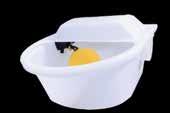

LAST YEAR saw a major shift in the supply of ATVs or quad bikes in the Australian market, with the Consumer Goods (Quad Bikes) Safety Standard 2019 coming into effect on 11 October 2021.
The standard was introduced to improve the safety of quad bikes, which are a leading cause of death and serious injuries on Australian farms: All new and imported second-hand quad bikes offered for sale in Australia, in all categories, must meet certain requirements of the US or European quad bike safety standards and have a hang tag attached displaying the angle at which that model of quad bike has tipped onto two wheels when tested for stability.
They must also carry a rollover warning label, have a compliant spark arrestor fitted and be supplied with an owners’ manual that includes rollover safety information.
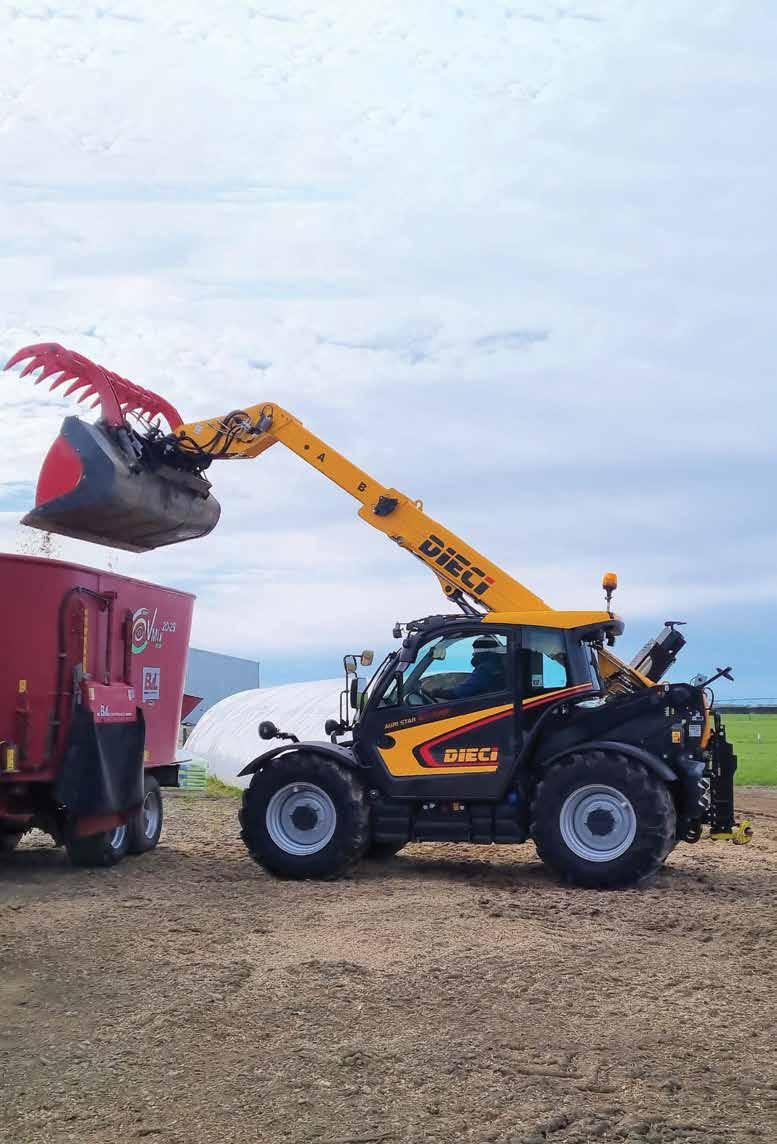
All new and secondhand imported generaluse quad bikes offered for sale must also meet the minimum stability requirements for lateral roll (sideways) stability, the minimum stability requirements for front and rear longitudinal (forward and back) pitch stability, and be fitted with an operator protection device or have one integrated into their design.
This last point appeared to cause the greatest concern to manufacturers, who said there was a lack of thorough testing as to the effect of fitting unauthorised devices, regarding stability and the changes to the centre of gravity. This point led to many withdrawing from the ATV market completely.
Brought about by the need to address the 180 deaths associated with the use of quad bikes since 2011, statistics look to have been on a downwards path anyway –probably through much
better operator training – with the number of deaths reduced significantly from the 24 lives lost in 2020, to 11 in 2021 and 9 so far in 2022.
Since the October 2021 deadline, the ACCC has worked with state and territory consumer protection and health & safety agencies to conduct a second annual round of surveillance activities, inspecting over 440 quad bike dealers in the process. The authorities are currently investigating a small number of instances where potentially serious non-compliance was identified, including in relation to the safety of the operator protection devices.
Summing up progress, 94% of new quad bikes assessed by the ACCC regulators were compliant with the national safety standard, an improvement from the 84% recorded in 2021. Non-compliance was mainly due to machines being displayed without age or rollover warning labels, lateral roll stability tags or owner manuals.
Back here in New Zealand, with the holiday season fast approaching and the increased chances of non-rural youngsters trying their hand at ATV riding, our own safety authority, WorkSafe, offers the following ATV/ quad bike riding tips:
■ Ensure you are properly trained before you ride a quad bike
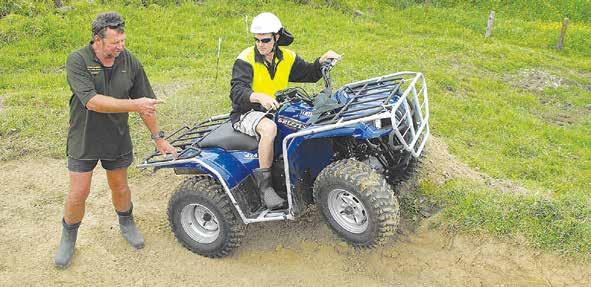
■ Always wear a helmet and appropriate clothing
■ Never let children ride quad bikes that are meant for adults — even as passengers
■ Do not carry any passengers on quad bikes that are meant for one person
■ Avoid riding on rough terrain or steep slopes
■ Take extra care in wet weather and be aware of obstacles
■ Never ride under the influence of alcohol or drugs
■ Ensure children are supervised at all times near any quad bike
■ Fit Operator Protection Devices to quad bikes minimise
injuries or reduced the risk of death.MARK
“We chose Dieci because of the functions – bigger engine, more oil flow, cameras; it’s a better specced machine than the rest. Once you’ve had one, you’ll never go back”
- Stu Russell, Dairy Farmer, Canterbury
may also bring larger, more frequent droughts in the North Island.
could make maize silage a more realistic fodder proposition for South Island dairy farmers, according to researchers speaking at the recent Foundation for Arable Research (FAR) CROPS 2022 event.


FAR senior researcher David Densley and researcher Owen Gibson spoke at the one-day event at FAR’s Chertsey research site near Ashburton, where a five-year maize project is in its second season.
They said Plant & Food Research climate modelling has shown that warming temperatures will allow maize to be grown in Southern areas which have previously been economically marginal, and
So, depending on future spring and summer rainfall patterns in the north, the South Island may become a major growing region for maize.
Maize silage demand from the dairy sector is increasing but economic yield and consistent forage quality are required for it to compete with imported palm kernel expeller (PKE) as a supplement for South Island dairy farmers.

Densley said that much of New Zealand’s maize agronomy is optimised for the major growing regions in the North Island but different management techniques may be needed in the South, where lower temperatures are a handicap.
He told the gathering
that the trial was about finding the optimum plant spacing to allow the foliage to capture maximum sunlight, since sunlight that reached the ground was “wasted energy.”
“If we narrow up the rows then conceptually we intercept more sunlight. Makes sense.”
In much of the North American corn belt 76cm “seems to be the sweet spot” but the further north you go narrowing the rows to 50cm or even 38cm actually had about a 2% to 8% yield advantage, he said.

Newer genetics also tended to have narrower root architecture to take
advantage of the narrower rows.
“Using the traditional row width and population density optimised for [traditional] growing regions may not maximise maize productivity and forage quality for South Island farmers,” said Densley.

Last season, an irrigated trial at Chert-
sey investigated Pioneer hybrid 8666 (CRM 86) planted on October 28, and harvested at 162 days. Row spacings were either 76cm or 38cm, and populations were between 95,000 and 120,000 plants/ha.
Owen Gibson explained that they had aimed for 100,000, 120,000 or 140,000 plants/ha but because the seed didn’t all strike to meet those targets, the trial didn’t produce results as significant as they hoped for.

Nevertheless, the narrow row spacing produced an average 2 tonnes of DM/ha improved yield – 30t DM from the 76cm rows and 32t DM from the 38cm rows.
A trial plot has again been planted this season to further investigate the interaction between row
spacing and population, with rows at 30cm, 40cm, 50cm, and 70cm and populations of 90,000, 110,000 and 130,000 seeds/ha.
Densley said that especially in the south with its shorter growing season, it was important that maize had a starter fertiliser to provide young plants with nutrient as soon as the initial nutrients in the seed were used up.
Typically, starter fertiliser was placed 5cm away and 5cm below the seed but FAR was researching putting in liquid fertiliser even closer to the plant.

He said yield potential is set by V5.

“From V3 to V5, which happens very quickly especially on the warmer growing season, we’re setting yield, so you better hit the road running by then.”


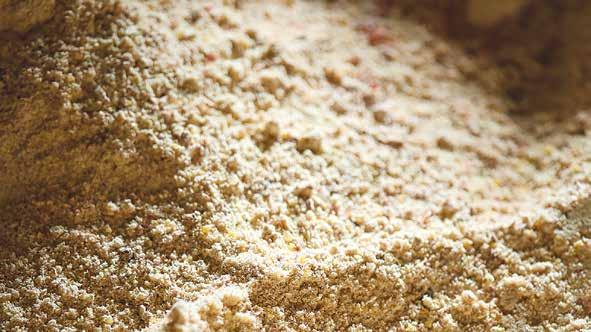
FERTILISER CO-OP
Ballance is taking delivery of the first shipment of phosphate rock from Queensland.
The shipment follows an initial feasibility trial of a small parcel of rock in July 2018. The trial shipment came as the Ardmore project came to fruition near Mount Isa.
Ballance says this provided the confidence to work closely with mineral resource company Centrex and its subsidiary Agriflex.
“For some time we’ve been looking to diversify our source of phosphate rock, a critical mineral required to maintain healthy soils, and find a source closer to New Zealand to help mitigate supply chain disruptions,” says Shane Dufaur, Ballance general manager operations & supply chain.
“Our security of supply for phosphate rock has been under a huge amount of pressure over the last 12 months, we’ve had to navigate many curve balls, some we expected, and others we
didn’t.”
In August, Ballance representatives visited Centrex in Australia to understand both supply chain and ESG alignment.
Dufaur says as a result the company prioritised this additional rock source.
Ballance expects to schedule further shipments over the course of 2023 and beyond, following a successful production trial of the current consignment.
Dufaur says it’s impos-
sible to overstate the importance of good soil health, it’s the very foundation for the high-quality food produced in New Zealand. As such the country needs to maintain surety of supply for critical minerals. The theme of this year’s World Soil Day (celebrated on December 5) reflects this – Soils, where food begins.
“When we get the balance right, healthy soil grows healthy food, protects our water quality and even helps reduce
greenhouse gases.”
Centrex chief executive Robert Mencel says that Ardmore’s phosphate rock sets a new environmental standard. Its natural ultra-low cadmium level eliminates the risk of heavy metal soil contamination and helps to maintain soil health.
“Agriflex’s unique solar drying process utilises the sun’s energy to naturally dry the product, eliminating the most significant carbon emission stage of phosphate rock produc-


tion. It’s very high grade and Australia’s proximity to New Zealand directly lowers carbon transport emissions on a %P basis.”
The primary role of Ballance is to provide an affordable and reliable supply of nutrients to farmers and growers.
“Together, by working with suppliers closer to home such as Centrex, we can continue to produce the best products in the world with the lightest environmental footprint,” says Dufaur.
WAIKATO REGIONAL Council senior technical advisor Bala Tikkisetty says soil is the most important resource to any nation, more importantly for farmers.
But he points out that in NZ we lose it to the ocean about 10 times faster than the rest of the world, with about 192 million tonnes sliding into the sea every year.
That equates to an astonishing 1.1 to 1.7% of total global soil loss to oceans, despite us having only 0.1% of total land area.
Tikkisetty says these statistics are a reflection of the erosion that results from our mountainous and hilly landscape, heavy rainfall events and some of our land use practices.
This will further intensify with impacts of climate change.
“Many New Zealand soils are inherently susceptible to erosion because of high rainfall, soft lithology, and steep topography.
“However, agriculture is not solely responsible for high levels of sediment input to fresh water across New Zealand. Urban development, mineral extraction, and earthworks also contribute to the problem.
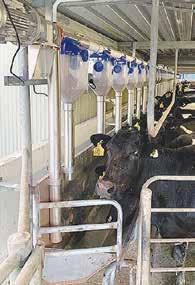
“And, as we all know, the resulting sedimentation of our waterways contributes to poor water quality and interferes with aquatic biodiversity, as well as affecting the backbone of our country’s economy – farming.”
"Hassle-free travel for mature travellers’’
• FAR NORTH & BAY OF ISLANDS (4 spots available)
7 days, depart 17 September. A leisurely coach tour of the Far North including the new Hundertwasser Art Centre and day trip to Cape Reinga.
• EAST COAST & NAPIER (6 spots available)
8 days, depart 21 September A unique and exciting tour around the East Cape and return via the Northern Explorer train
• CHATHAM ISLANDS DISCOVERY
8 days, depart 20 October A special place for a safe and relaxing close-to-home all inclusive holiday.
• BEST OF THE SOUTH ISLAND
15 days, depart 22 November A spectacular trip around the many highlights of the South Island taking in the wonders of Tekapo, Twizel, Stewart Island day excursion, the Milford Sound and Queenstown. Overnight cruise on the Milford Sound
• NEW PLYMOUTH 'CHRISTMAS LIGHTS'
5 days, depart 23 December A Christmas get away featuring the magnificent light display at Pukekura Park along with some great sightseeing during the trip.
• WAIKIKI BEACH & HAWAII CRUISE
11 days, depart 25 May 2023 A 'Pride of America' cruise for 7 nights with a Waikiki highlights 3 day stop over including Pearl Harbor and Oahu round Island tour.
• TAHITI & SOCIETY ISLANDS CRUISE
10 days, depart 21 July 2023 Set sail on board
Le Paul Gauguin for an unforgettable journey to discover idyllic sands and atolls. Tour includes flights to/from Papeete.
For full details
Phone 0800 11 60 60 www.travelwiseholidays.co.nz
AT THE recent National Fieldays, it was noted that Prime Minister Jacinda Ardern and her band of ministers avoided any Labour Party branding
For starters, Ardern didn’t do the traditional walkabout PMs usually do at the biggest agricultural event in the Southern Hemisphere
There were no Labour Party jackets or paraphernalia in sight
One journalist quipped that Labour wanted to avoid a repeat of what happened at recent field days in Hawke’s Bay and Greymouth, where Labour ministers out in the party’s red attire were subject to ‘unfriendly’ comments from more than a few farmers!
AND JUST like that, Fieldays is done for the year! That’s what Fieldays announced in a media release at the end of the four-day event However, there was no mention of the total number of people who attended the show Media reports put the number at 75,000, compared to the 2017 event where a record 133,588 people went through the gates
By all accounts, the event was smaller thanks to resurgent Covid, bad weather, logistical issues facing exhibitors and sheer timing of the event, which didn’t suit farmers or contractors
When the National Fieldays Society does it all over again in six months, they will be hoping for better numbers and a return to normal
COWS ON farms could soon have their health, reproductive readiness and location monitored by smart technology powered by the kinetic energy of the animal’s movements
Researchers from China, writing in the journal iScience, have designed a wearable smart device for cows that captures the kinetic energy created by their smallest movements The technology is housed in a scallop-shaped shell, which is attached to a cow’s ankle or neck
An electromagnetic generator converts kinetic energy into electrical energy, which is storied in a lithium battery that powers the wireless monitors
Information can then be gathered, including the amount of exercise the animal gets, reproductive cycles, disease, oxygen concentration, air temperature, humidity and milk production, helping ensure good health and improving breeding productivity
A STUDY by Swiss scholars and nutrition experts has found that plantbased drinks are not really alternatives to dairy milk
The dairyreporter com reports that laboratory analysis found that vitamin C, A and K2 could not be detected in the measured plant-based drinks
Vitamins B2, B12 and D2 were ‘almost absent’ in non-fortified varieties
To compensate, many of these ‘milks’ are loaded with supplements, sugar and additives
The Swiss scholars conclude that plant-based drinks are significantly limited in the amount of micronutrients they offer, unlike the superior cow’s milk
LOCAL GOVERNMENT rates have always been a bone of contention for farmers.
For farmers, it all boils down to cost fairness; they claim the existing system of property value rates is loaded against agriculture.
As Federated Farmers points out, farmers pay many more times than other residents for council services and infrastructure, even though some of those services aren’t even available to rural residents.
Federated Farmers Rates Report, an annual wrap of the lobby’s work advocating for farmers on council rates and local government policy turned up overall rate increases mostly below 10%, which compared to recent years is in a rather modest range.
Perhaps it being a local election year contributed to some newly found prudence.
However, there were exceptions: Environment Canterbury, which proposed a 24.1% increase for the 2022/23 year managed – under some pressure from ratepayers – to trim that to 16.2%. ECAN has been substantially increasing operating expenditure in recent years, and this is showing up on the bottom line for ratepayers. Westland District Council proposed a 12.5% increase but pruned this back to 6.9%.
Further north a push back on Taupo District Council’s proposed 8.35% increase, with a little bit ultimately taken off and the final number 7.07%. Wairoa was also near the 10% mark, with an average rate increase across the district of 9.1% for 2022.
Now, there’s another review underway of into the future of local government.
The Government says it is focused on prioritising ways to keep a lid on rate rises.
It supports efforts of local governments to engage with local communities in order to get the buy-in needed for any changes.
An independent panel doing the review will now embark on a round of consultation, with the wider local government sector to seek submissions, before producing its final report by June 2023.
For farmers it is a bald and unpalatable fact that in the decade to 2022, local authority rates and fees have gone up an average 56%, against a consumer price index rise of 20%. For them, and many other businesses and households too, the rates bill is a major, and climbing, cost.

They want robust debate during annual plan and budget rounds about targeted rates and uniform charges.
Farmers believe there are often a much fairer way than general rates of apportioning costs according to benefit derived. They find the current local government rating system unfair.
AUCKLAND SALES REPRESENTATIVE: Stephen Pollard Ph 021-963 166 stephenp@ruralnews.co.nz
WAIKATO SALES REPRESENTATIVE: Lisa Wise Ph 027-369 9218 lisaw@ruralnews.co.nz
WELLINGTON SALES REPRESENTATIVE: Ron Mackay Ph 021-453 914 ronm@ruralnews.co.nz
SOUTH ISLAND SALES REPRESENTATIVE: Kaye Sutherland Ph 021-221 1994 kayes@ruralnews.co.nz



The Government recently announced that recognition of on-farm sequestration will be a core component of its work to reduce New Zealand’s agricultural climate emissions ACT primary industries spokesman Mark Cameron claims the Government has adopted its long-held policy
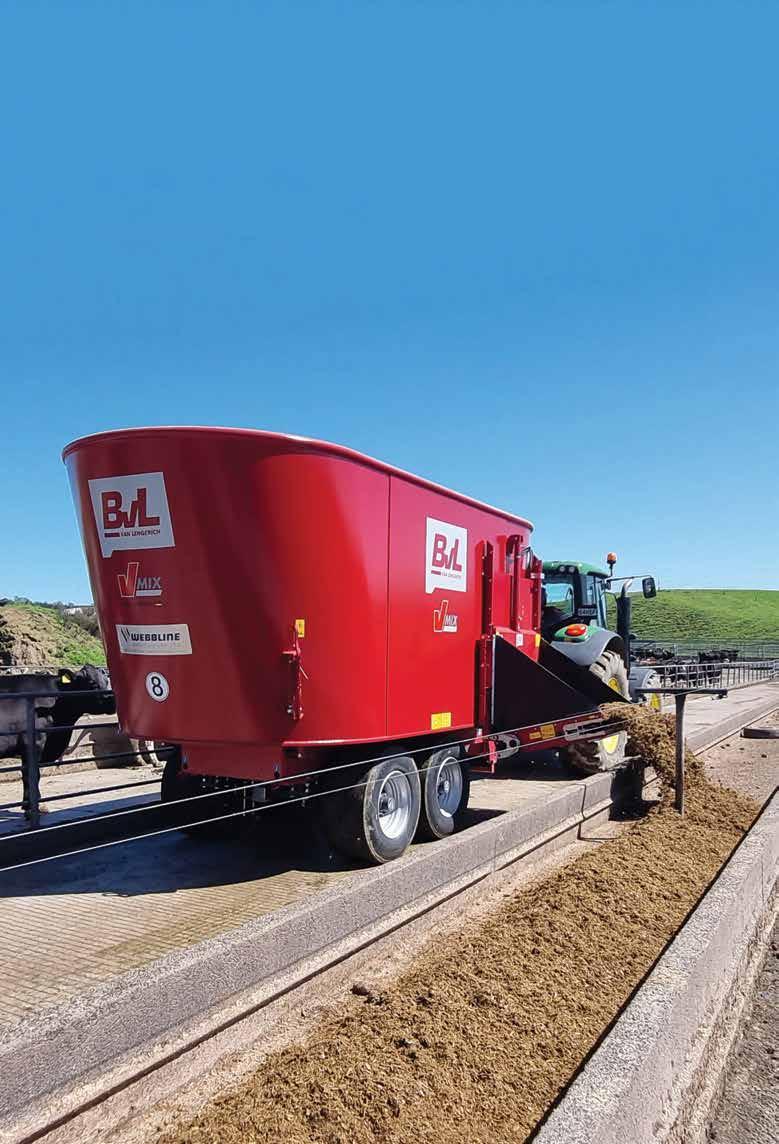
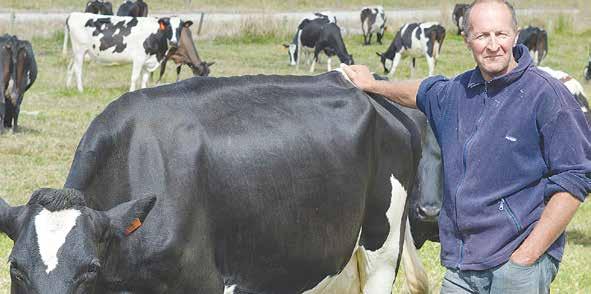
IT’S PROMISING
that the Government has adopted ACT’s long held policy of recognising on-farm sequestration for climate change. They should adopt the rest of our climate policy and
on policy they should also repeal the Zero Carbon Act and introduce a nononsense climate change plan which ties our carbon price to the prices paid by our top five trading partners.
take a practical approach to emissions that don’t hammer our agriculture sector.
ACT has long been calling for the Government to start properly rewarding farmers for the sequestration that already occurs on their farms and stop making out as if they’re environmental villains.
It’s good that the Government has finally seen sense on sequestration but they can’t use this as an excuse to continue with the burp tax. It will crush sheep and beef farming and increase global emissions as market share goes to less efficient countries.
The burp tax will ultimately be a food tax as prices of meat and dairy rise as a result.
It’s also about time they recognise that methane from livestock, as a short lived gas, has a very different effect on global temperatures compared to the near permanent effect of converting fossil fuel to carbon dioxide.
While they’re u-turning
There is no need to carry on with the charade that the Zero Carbon Act is anything more than a costly excuse for more bureaucracy with no impact on emissions. Other parties should be prepared to have an honest conversation on climate change like ACT is.
ACT proposes a realistic, no-nonsense climate change policy that matches our efforts with our trading partners’ with minimal bureaucracy. We should set a cap on total emissions in line with the actual reductions of our trading partners, then allow New Zealanders to import high quality foreign carbon credits so we pay the world price, not an artificial price.
Other parties are more concerned about appearance of environmental progress than actual progress.
ACT stands for real change in our climate policy, ensuring it is practical, effective, and not going to make life harder for New Zealanders.
“It’s good that the Government has finally seen sense on sequestration but they can’t use this as an excuse to continue with the burp tax.”
THE CHANCE to hear a leading US maize researcher at the Foundation for Arable Research’s premier maize event in early 2003 is described as a “once in a lifetime” opportunity.
FAR is hosting University of Illinois Professor of Crop Physiology, Fred Below. He will be keynote speaker at the event on February 14 at FAR’s Northern Crop Research Site at Tamahere near Hamilton.
Below is one of the researchers and authors responsible for the “seven wonders of the maize yield world”, the top seven list of management factors that each year can have a positive impact on maize yield.
The considerable gap between the average yield produced by most growers and record yields shows the opportunity to increase maize yield through enhanced crop management, he says.
FAR senior maize researcher David Densley says the opportunity to come and listen to Below is “probably once in a lifetime”.
Below has two presentations on the day: the morning keynote address is on emerging trends in maize production in the US and the last presentation on the day will discuss the latest maize research findings and why this will likely have an influence on maize production practices in the future.
Densley says that with increasing fertiliser costs and environmental requirements it’s an opportune time to


hear the latest research results.

Other speakers include FAR researcher Dirk Wallace on reducing nitrogen inputs, AgResearch scientist Trevor James on cover crops for weed management, Densley on precision agriculture for maize productivity and quality and FAR’s technology manager Chris Smith on sensor technology. FAR’s Abie Horrocks will discuss longterm crop establishment and some of the impacts that cultivation has on soil structure and water infiltration.
Apart from the keynote speaker, talks are repeated in the morning and afternoon. There will also be an update on the maize pest fall armyworm which was first identified in New Zealand in March last year.
Below will also attend an afternoon field day on February 15 at the property of Colin Jackson, Te Awamutu, one of the farmers hosting FAR onfarm maize research.
Densley says that FAR’s research always aims to answer one of three questions. “How can this research drive a grower’s profitability? How can the research help to bring more resilience into my production system and three, can it help me meet my environmental requirements moving forward?”
There will also be static displays on ProductionWise, E-Check, soil and plant nutrient sampling and biosecurity risks.

A NEW sustainabilityfocused podcast to support the country’s farmers and growers has been launched by Rabobank New Zealand.
The new podcast, RaboTalk – Growing our future, will feature informed opinions and healthy discussion on the future of farming and how primary
producers can adapt farm strategies and systems to ensure they thrive in a fast-changing world.
Hosted by Rabobank’s head of sustainable business development, Blake Holgate, the podcast will include interviews with a range of industry experts from New Zealand and around the world, with topics including long-term strategic planning, agritech, supply and value chains, and access to capital.
The first episode of the new podcast series was released this month and is now accessible via the Rabobank website and all major podcast apps.
Holgate says the new podcast has been established with the aim of equipping New Zealand’s farmers and growers with the knowledge to develop and maintain resilient

moment, and a key goal of the new podcast is to help listeners understand the changing landscape of the industry,” he says.
“As a global food and agribusiness banking specialist with a strong focus on market research, Rabobank is able to draw on insights gathered from the local food and agribusiness sector and from other key agribusiness markets around the world.
“And the intention with the podcast is to condense these insights down into digestible chunks for farmers and, in so doing, support them to make informed decisions about the future of their farming operations.”
The inaugural podcast episode features a conversation with Rabobank’s head of global rural and F&A Lara Yocarini.
As part of her role, Yocarini leads Rabobank’s Global rural team which is focused on connecting and growing Rabobank’s
rural businesses in New Zealand, Australia, Brazil, Chile, Peru, Argentina and the US.
“In the episode, we discuss how sustainability is influencing capital markets around the world, how banks are responding, and ultimately how this will flow through to impact New Zealand’s farmers and growers over coming years,” says Holgate.
Other topics featured in episodes scheduled for release throughout December and January include the role of onfarm planning, the impact of changing climatic conditions on future farming systems, and how sustainability is influencing food supply chains.
“We’re really excited about the new podcast series as we see it as another way we can help our clients, and the wider farming community, to achieve their business goals,” he says.
A SOLUTION to help farmers complete the animal wellbeing part of their on-farm assessments will be available from this month thanks to a new relationship between WelFarm and Fonterra.
“We’ve just established an automated link which allows us to notify Fonterra when a farm has completed their Animal Wellbeing Plan with their vet through WelFarm,” says WelFarm general manager Samantha Tennent.
“It means it’ll be one less piece of paper they need to gather when preparing for their assessment.
“And the plans are stored in the WelFarm portal so when farms do want to refer to them they can easily log in to find it, which saves sifting through emails or
requesting another copy from their vet.”
WelFarm developed their Animal Wellbeing Plan template in 2021 in response to the updated requirements from Fonterra for the Co-operative Difference.
“We recognised we
were in a unique position already connecting vets and dairy farmers through the wider WelFarm programme,” Tennent says.
“So it made sense to include a simple method to help them develop their Animal Wellbeing Plans and leverage their
data further.”
The WelFarm programme is a framework for proactive herd health and welfare management for a dairy herd. It has a simple reporting method and provides regional and national benchmarking through the web-based
platform that gives context to herd data. The programme supports the relationship between the dairy farm and veterinarian, helping vets provide tailored advice and support.
If a farm is using the wider programme some of
their metrics feed into the Animal Wellbeing Plan directly which gives vets and farmers more information to discuss as they develop their plans.
“Having a consistent approach to develop plans is valuable for farmers, Fonterra and the

UPDATES TO animal evaluation being made this month are designed to give farmers more confidence in the data and better reflect their individual herd.
Two key changes will be made: the first will help New Zealand Animal Evaluation Limited (NZAEL) identify what proportion of a Holstein Friesian animal is made up of Holstein or Friesian. The second change is said to better reflects today’s milking lengths by allowing herd testing data collected up to 305 days of milk to now be included in the animal evaluation.
These changes are part of NZAEL’s
commitment that data captured in the DIGAD (Dairy industry good animal database), informing its animal evaluation, is accurate and provides meaningful insights for farmers.
“Quality data going into the DIGAD is really important. Farmers need to have confidence that the data that they use to make their breeding and culling decisions is the best it can be. Our team compares every AE run to those before it and identify areas for improvement,” says Andrew Fear, manager of NZAEL.
That’s how the change to breed proportion for Holstein and Friesian has been implemented. From Decem-
ber, NZAEL will now be able to identify the proportion of Holstein and Friesian in an individual Holstein Friesian animal for the purpose of animal evaluation.
There are a number of differences between Holsteins and Friesian animals and so it is important to understand the breed proportion in any individual Holstein Friesian animal as part of the Animal Evaluation process.
“The new formula is expected to be more accurate as it recognises variations between animals and is set based on individual herds. Farmers can expect more stability and accuracy in their herd,” says Fear.
The update to days-in-milk to include all data collected up to 305 days of lactation is a change that better reflects today’s milking practices. Many herds have extended the length of their lactation beyond 270 days and were missing that data being included. Andrew says that it was time to make the change to better reflect this for farmers.
“The cut-off of 270 days was historical and we knew this wasn’t an accurate reflection of today’s milking days. From December, any animal who is herd tested up to 305 days of lactation, that data will now count towards its evaluation.
wider sector and using our system gives peace of mind as our template is live and gets updated as Fonterra’s requirements evolve,” Tennent says.
“This saves any back and forth if any updates were missed.”
The WelFarm programme is available through a number of vet clinics across New Zealand and more clinics join regularly. Tennent encourages farmers to ask their vet if they are already part of WelFarm or if they would consider joining.
They are also looking at other potential connections to support automatic data sharing to reduce the administrative burden and give farmers even more value from their herd health data. More information can be found on WelFarm’s website welfarm.co.nz
“Farmers who have been herd testing beyond 270 days have been missing out on the inclusion of that valuable herd testing data attributing to their animals because of the cut off. Allowing this extra data means we will have more accurate Breeding Worth.”
The changes are small, but with more accurate data available on their own herd, farmers can feel more confident when making breeding decisions for the next.
Fear encourages farmers to use the tools available to them from NZAEL including the Bull Search and Bull Team Builder as well as working closely with their AB provider.
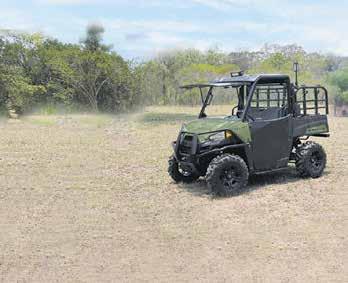


“We recognised we were in a unique position already connecting vets and dairy farmers through the wider WelFarm programme.”
A PROJECT to develop a sustained release methane inhibitor technology for grass-fed animals has received a funding boost from the Government.


Ruminant BioTech’s CALM (Cut Agricultural




Crown’s cash injection.
The company aims to develop a commercially viable bolus by 2025 that delivers at least a 70% reduction in ruminant animals’ methane emissions over six months.
Ruminant BioTech chief executive George Reeves says the bolus has the potential to provide every dairy, sheep,
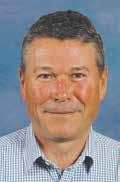
and beef farmer in New Zealand with an effective, easy, “set and forget” methane reduction solution that is both highly effective and practical for grass-fed animal farming operations.
“Our slow-release bolus delivers a methane inhibitor at the site of methane production, in the rumen. Prelimi-
nary trials achieved 90% methane emissions reduction over 80 days. While these initial results were extremely positive, our goal is to develop a bolus that achieves 70% methane mitigation over six months,” explains Reeves.
He says the methane inhibitor bolus is unique and has the potential to deliver significant climate change impacts.
“New Zealand has a unique greenhouse gas emissions profile. Almost 50% of our total GHG comes from agriculture and three quarters of this comes from methane produced by ruminant animals.
“While most countries around the world can meet their methane reduction targets by increasing clean energy sources, New Zealand’s situation is more complex. We are heavily reliant on agriculture for export revenues and employment, which must continue.
“Yet we need to materially reduce agricul-

tural methane emissions to help New Zealand achieve its 2030 reduction target of 10% below 2017 levels.
“Other methane mitigation products in development are primarily feed additives. However, because New Zealand farms are grass-fed systems, feed additives are not a very practical solution.
“The aim is for our bolus solution to be suited to every ruminant animal, on every New Zealand farm. There is no other solution currently available anywhere in the world like it. It’s a real game-changer,” says Reeves.
To date, the company’s focus has been on delivering a large cattle bolus for cattle weighing over 300kg.

The Government funding will allow it to accelerate development of current bolus for large cattle, while also developing bolus solutions for smaller cattle and sheep.
BOLUSES ARE a common mechanism to deliver drugs and trace elements/minerals to ruminants and have been used safely for around 50 years in the farming industry.
A bolus is a like a large capsule which sits in a ruminant animal’s stomach and continuously releases, at a slow pace, an optimal dose of a drug or substance. In our case, that substance is tribromomethane.
The dose of tribromomethane the animals receive over time should be low enough to be safe for animal, food and the environment, while high enough to achieve significant levels of methane reduction.

Ruminant BioTech says this needs to be verified by its comprehensive animal research plan, but based on initial data they have, there is no cause for concern.
Reeves confirms the company’s research and development programme will focus on fine-tuning the product technology over the next three years, including robust testing to ensure the solution is safe for animals and does not impact on the quality or safety of the food they produce.
Reeves confirms that if the Ruminant BioTech bolus is broadly adopted it will have a significant
effect in reducing New Zealand’s net greenhouse gas emissions and help enable the country to achieve its 2030 emissions reduction targets.
Ruminant BioTech’s research team will work closely with farmers, supply chain partners and industry bodies as it furthers product development.
https://www.ruminantbiotech.com/

IN LINE with its motto
“Next Generation Farming”, GEA recently announced innovations in the field of conventional milking at EuroTier.
The focus of the new developments is primarily on the digitalisation and networking of conventional solutions.
GEA says the new products will be launched in New Zealand after learning from test farms.
GEA announced details of the new DairyMilk M6750 milking control unit for the first time. Connected to the GEA DairyNet herd


GEA ALSO announced a new milking rotary parlour at EuroTier with the new DairyRotor T8600. This new outdoor milker will be equipped with the future generation of DairyMilk M6750 milking control units.
By connecting to GEA DairyNet, it will be the first conventional GEA milking system whose components and processes are digitally networked across the board.
This enables extensive services in real time and via remote access. Daily system maintenance and minor servicing can also be carried out on the new GEA DairyRotor T8600 during milking without
interrupting the process. The modernised, modular design of the milking system and its components means that farms can easily benefit from future software and hardware upgrades. The modular design is also said to significantly increases installation and maintenance convenience for dealers and service technicians.
The company says the new GEA DairyRotor T8600 is a flexible all-rounder with 28 to 120 milking places and is suitable for any farm. It can be used for farms worldwide with both barn and pasture-based system. A “second round” func-
AT EUROTIER, GEA presented the DairyMilk M6750, a new generation of control units for conventional milking.
These new milking control units feature state-of-the-art, networked sensor technology and data management in real time.
Thanks to a comprehensive network and the GEA DairyNet connection, current data can be displayed, key figures of the milking processes can be viewed and service and maintenance work as well as comprehensive system monitoring can be carried out via remote access.
The user interface is based on a language-neutral concept with intuitive operation.
On the terminal at the milking stall, four luminous surfaces use different colours to indicate the status of the ongoing milking/cleaning process as well as alarms.
A modular product design allows
tion allows individual animals on the carousel to be checked again, while the ongoing milking process for the entire herd proceeds uninterrupted. Depending on the layout of the installation, the T8600 also offers a comprehensive equipment package for economical one-person-milking.
The entrance area, which can be adjusted according to cow size, and the slim milking stall design are said to have a positive effect on animal comfort and a safe, quick change of animals. GEA has also made the entire supply chain more sustainable for the DairyRotor T8600: Pre-assembled
farms to select the scope of functions individually. Additional functions can be easily retrofitted later. Thanks to the associated software and plug & play hardware, the system can be configured and installed more quickly, resulting in time and cost savings during installation and commissioning.
GEA has also optimised the supply chain concept for the new milking control units.
A pre-assembled scope of supply replaces several individual deliveries, which means that installation is faster and almost waste-free. The market launch of GEA DairyMilk M6750 will initially apply to the new T8600 milking carousel and the existing T8900 carousel.
Retrofitting for all other conventional GEA milking systems will be successively available worldwide in parallel with the availability of GEA DairyNet.
management system, it offers comprehensive digital services in real time and via remote access. GEA’s new rotary milking parlour – the DairyRotor T8600 – will also be equipped with this new generation of milking control units.
The company says it will thus be the first conventional GEA milking system with cross-system networking.
In developing the new solutions for conventional milking, GEA says it has also focused on improving comfort for cows and operators. Service and

installation will be faster and easier in the future, it says.
Optimised supply chains also significantly reduce packaging resources and waste on site.
Design, handling and configuration options are based on the specific needs and wishes of dairy farms worldwide. The entire product development process was guided by an extensive customer survey that GEA conducted in various countries in advance.
A NEW study has found that dairy farmer investment in composting shelters is being driven largely by a desire to tackle environmental challenges, improve animal welfare, provide labour efficiencies and better working conditions for staff.
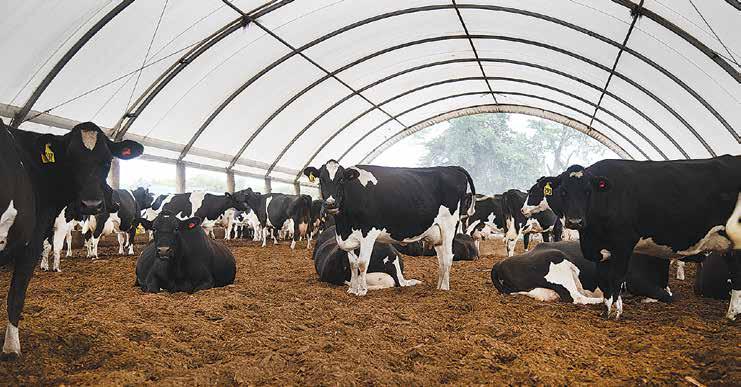
The project, Whole systems impact of composting shelters in New Zealand, was led by Perrin Ag consultant Rachel Durie. She had support and input from Keith Woodford of AgriFood Systems Ltd, and contribution from a Māori-owned agribusiness who provided their farm as the case study. It was funded through the Our Land and Water National Science Challenge under the Rural Professionals Fund 2021
The study reports on the knowledge and experience of six farmers (Waikato, Canter-
bury, Hawke’s Bay, Otago and Southland) already using composting shelters within New Zealand.
It also quantifies potential impacts to farm systems on the Māori-owned case
study dairy farm in the South Waikato.
Durie says while widespread in the Northern Hemisphere, composting shelters are a relatively new concept in New Zea-
land.
“Composting structures are already in operation in New Zealand on some early-adopter farms. In most cases, the shelters are incorporated into

the system year-round in a hybrid indoor-outdoor grazing system. In this system, cows will spend a portion of the day in the shelter and a portion outdoors on pasture.
“The proportion of time cows spend in the shelter will vary depending on the individual farm system and the desired outcomes. However, there is a general trend of utilising the shelter at nights during the cooler autumn and winter months and using the shelter during the day in the warmer months.
“There are some farms using the shelter solely as an alternative wintering system to grazed crops. This is particularly the case in the South Island where winters can pose considerable environmen-
tal and animal welfare challenges.”
Intangible benefits a big drawcard


While all farmers interviewed as part of the study reported improved financial performance, it was the intangible benefits of composting shelters they weighted most highly.
“Labour shortages, environmental performance and animal welfare considerations are all significant challenges that dairy farmers are grappling with on a daily basis,” says Durie.
“The farmers we interviewed saw increased cow comfort and welfare, better staff working conditions, a lift in labour efficiency, improved environmental performance, and reduced pas-
ture damage as real drivers for their investment.
“They noted benefits to animal welfare through the provision of a comfortable environment that protected cows from both the heat in summer and cold, wet conditions in winter.
“For staff, the shelters mean they can work out of the weather, which is particularly beneficial during calving. Where the shelters replaced winter grazing, there was a significant workload reduction. The ability to manage over-grazing and pugging damage also reduced farmer stress.”
Other farmers noted a reduction in calf mortality and a pleasurable experience for staff and animals over the calving period. One farm has even installed cameras to allow staff to complete night calving checks remotely.


In addition to these intangible benefits, the farmers reported a significant reduction in their winter feed requirements compared to a 24/7 outdoor system, due both to reduced maintenance requirements and feed wastage. One farm noted a 50% drop in the winter feed allocation relative to their previous winter cropping system.
MODELLING OF composting shelters on the South Waikato case study farm demonstrated several key financial benefits for the business:
45% reduction in nitrogen leaching loss

33% increase in per hectare cash operating surplus
14% increase in milk production - due to improved feed conversion efficiency, improved pasture growth and mitigation of cow heat stress over summer.
8.5 - 12.7% pre-tax internal rate of return (IRR) on the investment (marginal return) over 50 years depending on the level of capital costs. At the whole business level, this provided returns of 6.8%7.4%, compared with 6.3% for the status quo. Returns at 25 years were similar.
Key drivers of returns included capital cost, bedding expense, milk price and production.
“Our desktop modelling indicated that incorporating a composting shelter on the case study farm could provide an environment in which the land, animals, people and business could thrive,” says Durie.
“It is clear from our study that composting shelters have diverse benefits to the human environment, the biophysical environment and to animal welfare, and contribute towards enhancing land, water, climate and living communities.
“However, farmers considering composting shelters need to carry out sufficient personal research before committing to the project, to make sure the design is fit for their farm’s specific location and purpose.
“While there is still a lot more we need to learn, our findings have demonstrated that composting shelters have the potential to become a transformational technology for the New Zealand dairy industry.”
HALTER AND LIC have partnered to allow data flow between the Halter app and MINDA, saving farmers time.
From this month, the Halter platform will send accurate heat alerts to the MINDA app, LIC’s cloudbased herd management system, allowing farmers to schedule drafts within MINDA for on-heat cows.

Halter farmers will also gain access to some of their herd’s MINDA data via the Halter app, including calving date, mating sire ID and body condition score, providing them with an overall picture of herd performance, health and fertility to help them make more informed decisions on farm.

Halter chief executive Craig Piggott says the integration is indicative of Halter’s rapid pace of innovation, flexibility and commitment to farmers’ needs.
“From day one, our goal has been to make farmers’ working lives better. Integrating Halter into MINDA is something farmers have asked for, and we’ve responded,” says Piggot.
“It’s a perfect example of how Halter helps. Our integration simplifies the admin so farmers can get on with more important jobs.”
LIC chief execu-
tive David Chin says the farmer-owned co-operative is pleased to welcome Halter to its growing suite of wearables partners.
“Enabling MINDA to integrate with cow wearables is key to unlocking more value for our growing number of farmers who have invested in this technology,” says Chin.
“We’re excited to partner with Halter to provide more farmers with improved access to data and insights to make their lives easier.”
Piggott says the integration is an important step in the tech company’s evolution. He looks forward to continuing to foster relationships with partners who share a vision to support farming communities.
“We are on a path to an ecosystem where we connect partners to farmers to help drive business success. This LIC integration is the beginning of that journey.”
Founded in 2016, Halter is made up of over 180 engineers, data scientists, farmers, designers and business people. Collars are leased under a per-cow subscription model – based on the features farmers require.
Halter retains ownership of the collars and therefore takes responsibility for their mainte-

nance. The company is backed by Founders Fund, along with Rocket Lab’s Peter Beck, K1W1 and Blackbird VC Fund.

Bore water pre-cooling is not necessary with the correctly sized PIB. This is ideal for



 DANIEL markd@ruralnews co nz
DANIEL markd@ruralnews co nz
YAMAHA HAS increased its offering of side-by-sides with the introduction of the Wolverine X2 Utility.

Designed exclusively for New Zealand farms, with an emphasis on work rather than recreation, the machine takes details from the successful R-Max and adds a rear load tray from the existing 3-seater Viking series. That rear deck is wider, deeper and able to take a pallet, so with its 272kg load capacity, alongside a 907kg towing capability, the X2 Utility is certainly equipped for work.
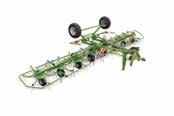
We took the opportunity to live with the X2 for a couple of weeks to see what it performs like on a day-to-day basis.
First impressions are a solid stance and a sizeable vehicle, tipping the scales at around 800kg. Just like the Henry Ford mantra, the X2 is available in any colour, so long as it’s Yamaha blue. The easy-
access half saloon doors have internal-only release levers so there’s no exterior fittings to get caught in obstacles.
A comfortable seating position is achieved by an adjustable steering column and a sliding seat base, with bucket-style, high-backed seats offering plenty of support.
The engine fires up instantly before immediately settling to tick-over. Gear selection is via a centrally mounted, gated shift lever, offering high/ low/neutral and reverse, which each slot into place smoothly with a dab of the brake pedal. A rotary knob to the left of the steering wheel offers the choice of 2WD, 4WD or
4WD with locked differential.
Moving off, the X2 accelerates smoothly and builds speed in a controlled, linear manner, utilising the ample power provided by the Yamaha twin cylinder, 847cc, fuelinjected and dry sump motor that is isolated via rubber mounts to reduce vibration and limit noise.
As part of the control package, a management key located under the front hood allows owners to limit maximum speed to 40km/h to suit user or operating conditions.
On rural roads, farm tracks or any type of rough ground, the KYBequipped suspension system simply soaks up undulations or sidling

land, making the most of the independent wishbone layouts front and rear, with 221mm and 236mm of travel respectively.
Aluminium wheels with 27-inch tyres offer excellent stability in all types of terrain. Dual disc set-ups all round pull the vehicle up safely and smoothly, even when
the vehicle is loaded to its maximum operating weight. Of note is the Ultramatic Drive system that uses a sprag clutch assembly to provide downhill engine braking and retardation, meaning the operator is always in control, allowing descents without the need to overuse the brake pedal.
Well-weighted elec-

tronic power steering makes it easy to steer the machine at all speeds and ground conditions, even when fully loaded. In the cab, machine status is readily available on the central information display.
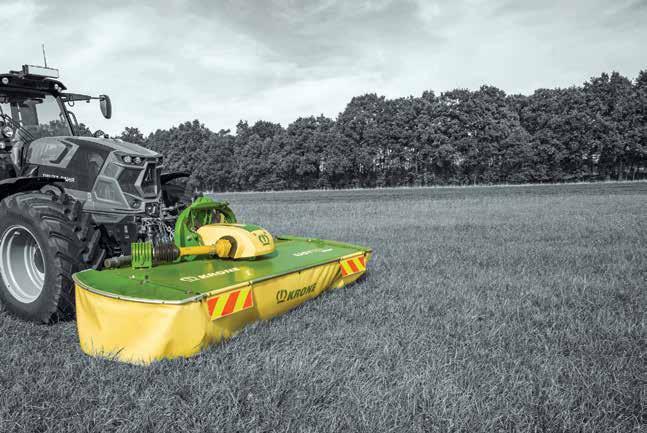
A central cubby between the seats offers large capacity for all the tools needed out on the farm, complemented by a passenger glove box and numerous cubby holes and shelves.
What’s not to like? Thankfully, not too much and it’s largely down to personal preferences. In its shortest position, the clearance between the silencer guard and trailer couplings is a bit tight for large hands, the lateral shoulder bolsters restrict rearward vision when reversing, so the X2 needs some rear view mirrors, and by far the biggest gripe, the operator footwells need some drain plugs to allow an easy clean out from muddy boots.
MANUFACTURED IN
northern Poland, Samasz is present in around 50 markets worldwide, but although it offers an extensive range of grassland products, including rakes and tedders, it’s probably best known for its high performing mowers.

Samasz is exclusively distributed in New Zealand by Kaiwaka-based FarmShop. Their relationship with the manufacturer began in late 2019 with a wholesale division that supplies an expanding regional dealer list.
Well known for design, durability and outstanding performance, the latter is evidenced by a Guinness World Record for the largest area of grass mowed using a triple, butterfly combination disc mower, knocking over 96ha in just eight hours.
Samasz began trading in 1984, always following a customer-first philosophy
that in turn is backed by a two-year warranty that shows confidence in their product and keeps them ahead of the pack.
Meanwhile, with an eye to the future, constant testing, ongoing upgrades and an extensive product development programme mean the machines evolve to meet changing conditions and customer feedback.
The extensive mower range includes drum and disc formats, with belt or direct dive, plus front, rear and combination configurations to cover all types of crop, conditions and enterprises.

The company notes that its PerfectCut cutter-bars are over-dimensioned, wide, and incorporate 25mm-thick drive gears. This is said to offer superior contour following, particularly over uneven ground such as pivot irrigator ruts. The mowers also feature Quick-Change modules on the cutter-bar, changed quickly with minimal downtime, alongside
being geared up, meaning that the main driveline components run at a slower speed to guarantee a longer working life.
The blade design features a 13.8mm overlap, thereby
eliminating striping, and can spin 360 degrees to generate a self-cleaning effect and a quick-change system to minimise service downtime.
www.farmshop.co.nz

THE NEW Zealand Dairy Industry Awards (NZDIA) programme recently announced a new national sponsor with the agricultural and industrial tyre and wheel manufacturer Trelleborg joining the existing cohort of supporters.
The prestigious awards programme drives best practice, celebrates and showcases the very best of the New Zealand dairy industry, with entrants connecting, learning and growing as individuals across the three categories of Dairy Trainees, Dairy Managers and Share Farmers, while farm owners are also recognised through the Fonterra Responsible Dairying Award.
NZDIA general manager Robin Congdon says organisers are delighted to welcome Trelleborg into its family of national sponsors and partners.
“They are keen to get involved, build their brand in rural communities and help us drive improvements in dairy farming. I was intrigued to find out more about the Trelleborg brand and now know they are a substantial global organisation offering many solutions in the agricultural industry as well as many others.”
Back in 2018, Trelleborg acquired New Zealand tyre distributor TRS Tyre and Wheel Ltd, who are headquartered in Whanganui and also distributes the well-known Mitas brand in the dairy farming industry, with fitments for tractors and implements.
“Trelleborg is the market leader in agricultural tyres and through technology and innovative products, this allows us to support farmers by increasing their productivity and reducing operating costs,” says Mark Prentice national sales manager for TRS.
“We’re

nz
WITH INPUT costs still riding high because of ongoing global events,

scrutinisation of machinery operational costs has come to the forefront.
Tractor and grassland machinery manufacturer Fendt wanted to test the efficiency of its TIGO



loader wagons, in June 2022 handed a machine over to the renowned DLG organisation in Germany to take a closer look.
Focusing on their
■ 2.2m wide cam-less pick up with seven tine bars
■ 880mm diameter chopping rotor with 45 knives at 37mm spacing
■ Chain and slat floor conveyor system
■ 50 cubic metre capacity/ permissible maximum weight 31,000kg

■ Dimensions 10.75m long x 2.95m wide by 4m high
■ Power requirement 230hp+
TIGO 90XR-D model, the machine was compared with a competitor machine in like-for-like conditions, looking at the key areas of throughput, fuel consumption, power requirement and of course, consistency of chop length. The overall result showed the Fendt machine delivered high output and consistent chop quality, but importantly, required less horsepower and used significantly less fuel.
With farmers and contractors being subjected to what appears to be shorter operating windows, placing increased pressure on staff and machinery, the TIGO delivered an average output of 130 tonnes of fresh material per hour at maximum operating speed of 19km/h in a crop of 38.6% dry matter. By comparison, the direct competitor managed on 118 tonnes per hour, meaning the TIGO output was about 10.8% higher.
In order the make the
power requirements of the loader wagons comparable, a target density of 220kg per cubic metre and a 125 tonnes per hour target was set. Compared to the competitor set up requiring 246kW, the TIGO achieved the predetermined target with 206kW, meaning around 16.6% less power was required.
This also meant fuel consumption per tonne was reduced to 0.44 litres per tonne against the competitor’s 0.49 litres per tonne – a saving of 10.4%, despite 6% higher compaction values.
Looking at the important areas of quality of chop, pick-up losses and contamination, the TIGO delivered 40% of the chop in the key 25-50mm range, 0.3% pick-up losses, compared to 0.9% for the competitor, and no fodder contamination, resulting in the machine being awarded a DLG-approved award for functionality and quality of work (DLG Test Report 7293).






